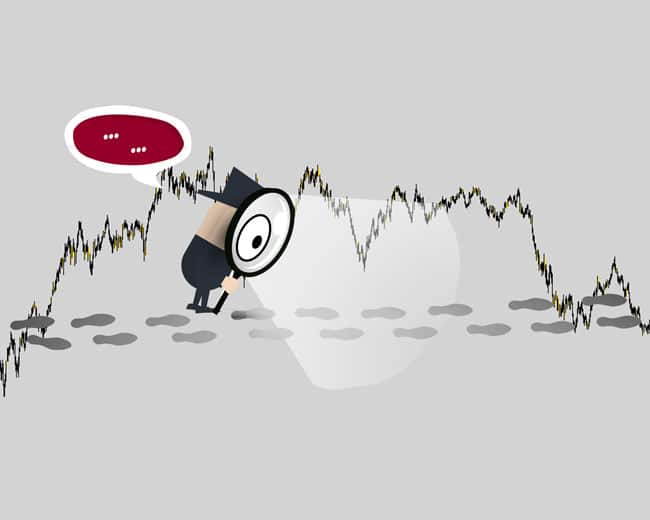
By observing how the market moved in the past, you can begin anticipate future price movements with better accuracy.
Right now, I have a have an open trade on the GBPAUD. Currently the market is moving against me because the trend is correcting back to the mean.
As a result my open profit is decreasing. I am not going to let that unhinge my discipline or scare me into closing the trade pre-maturely, however.
I know from studying Forex historical data that these types of movements are just ‘natural’ and there is nothing to be scared of.
In today’s article I wanted to take you through some of the observations I’ve made from studying the Forex historical data, and how it helped me become a better price action trader today. The truth is, the information I am going to share with you today will help you regardless of what trading style or system you have.
Once the train gets going, don’t expect it to stop suddenly
What train? I am talking about the ‘trend train’ of course. Trending markets are the easiest market conditions to make money in. If you catch a good trend you can literally hold your position to milk the markets for some big returns – if you’ve got the patience of course.
So if trends are so easy to trade, why are 95% of Forex traders still losing money in these ideal trading conditions? I believe it’s because of two reasons.
- The trader is trying to continuously pick tops and bottoms
- The trader has lost perception, or doesn’t have a good enough understanding of how trends move as they climb into higher or lower prices.
This stuff sounds really simple right? You think ‘oh yeah, I know all this stuff already’. But when you’ve got a trade open, your mind plays tricks on you and you start doing all sorts of silly things you know you shouldn’t be doing.
Let’s go back through some Forex historical data and have a look at some trending conditions…
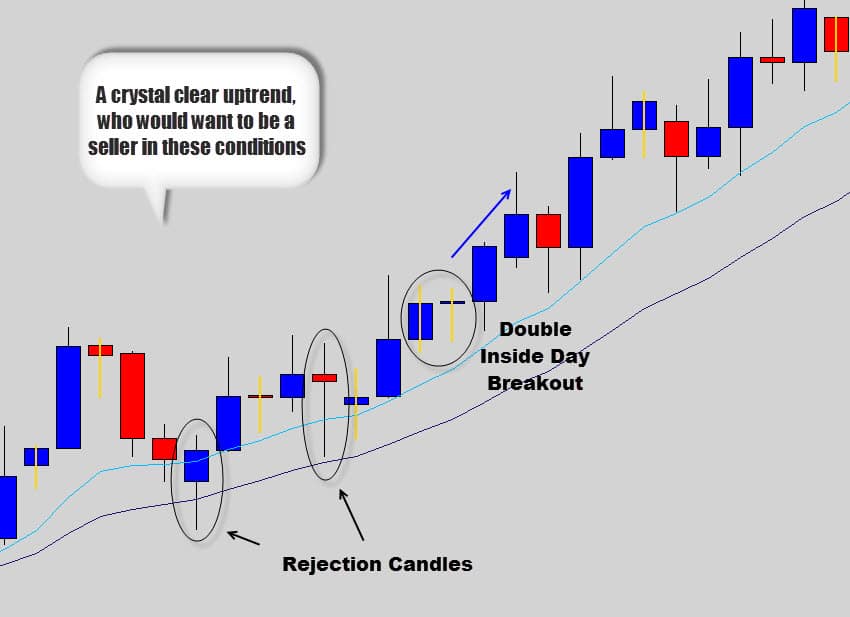
The chart above is a snapshot of the 2011 bullish markets from the AUDUSD Forex historical data. Take a good look, study it, and really soak in what happened as this trend unfolded as price climbed higher. Take in what trading opportunities were available to you.
The majority of retail traders were probably trying to sell the market all the way up, hoping to catch a top. But we can clearly from the Forex historical data, once a developed trend like this gets moving, it’s not that easy to stop. This reminds me of a freight train, if it needs to stop, the train requires a few kilometers train tracks to do so. Let the Forex historical data show you how the market likes to move.
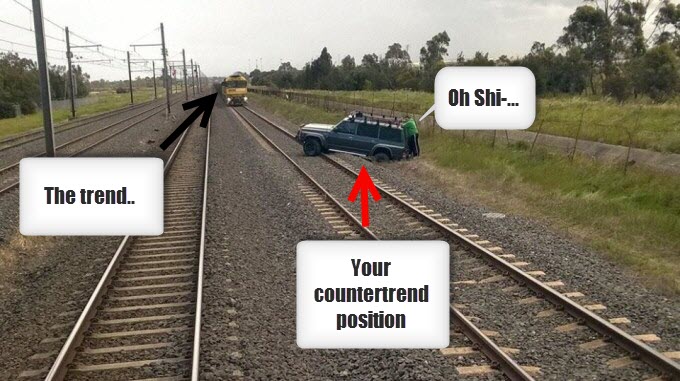
If your car broke down on the railway crossing, and a speeding train was coming your way. Don’t expect the train to stop in time to save your car. No, the train is going to ram through that train crossing and take your car out along with it. Just like if you trade against the trend movement, don’t expect the trend to suddenly stop and reverse on your behalf. It’s most likely going to bulldoze straight through your stop.
Yes, timing is important. There are better times to enter Forex trends than others. Generally speaking, don’t throw yourself ‘under the bus’. Only under special conditions should you be considering trading against trend movement.
Let’s have a look at another trending environment from the Forex historical data…
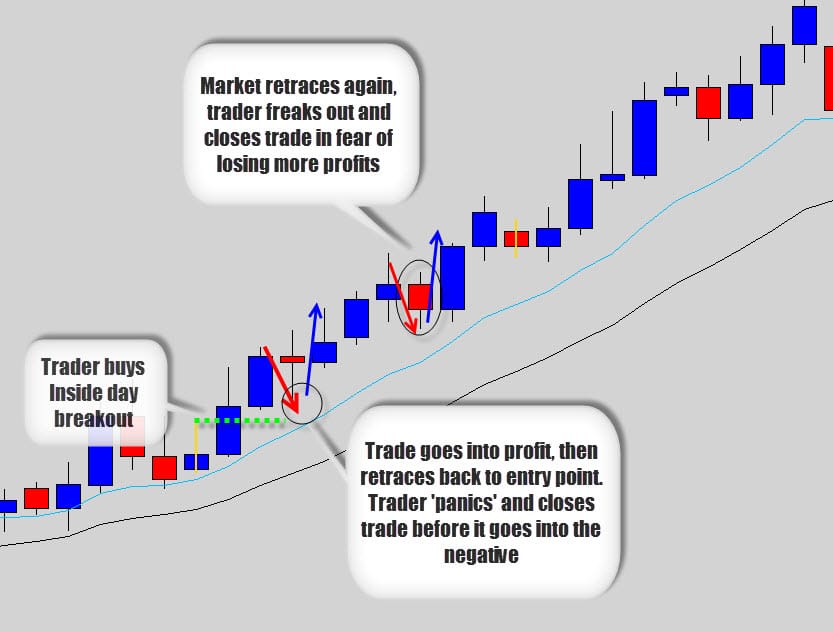
The chart from the Forex historical above shows another example of an up trending market. In this particular scenario we are looking at nice bullish Inside Day breakout trade. This setup had the potential to produce a large return. But instead, most traders would have cut their trade prematurely out of fear.
The initial trouble area for most traders would have been the first market retracement. Those traders who sat there and watched their price charts all day would have probably pulled the plug on this one too.
While the market was correcting back to the mean, it started eating away at the open trade’s floating profits.
Weak traders crumble under the pressure and make regretful decisions. For the traders who remained discipline, the trend recovered and the trade and were rewarded with a healthy return.
Looking further on into the Forex historical data, the chart demonstrates a second ‘trouble areal. The next bearish candle which had a moderate bearish close into the body. Lots of traders would have freaked out here too because the trade moved against them and started taking away their profits. Again, most traders bail at the first signs of trouble.
As I said before, these trending markets offer so much reward. Despite the good opportunity, traders continuously sabotage themselves. This self-destructive behavior is fueled from the ‘fear of losing money’. This mentality blocks a lot of traders from allowing their trades to progress naturally into a healthy return.
The majority of traders are too fixated on making money to pay attention to what is happening, learn from, and actually become good traders. The ironic thing is, focusing too much on the $$$ will generally lead to a thought process where your money dissipates back into the market.
If you take the time to study the Forex historical data and really look at all these trend movements, you would probably be less likely to self-sabotage your positions in the future. What you’ve got to understand is, the market doesn’t move in straight lines, it zig-zags up and down as price crawls into higher, or lower prices. Take a look the bearish trend from the Forex historical data on the Gold spot market.
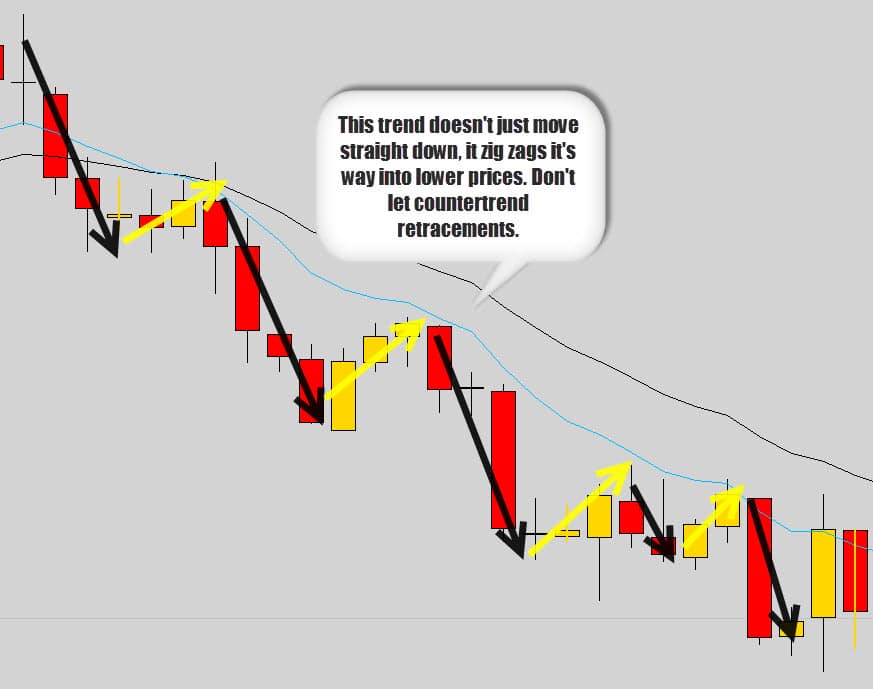
In the Forex historical data chart above we are looking at a nice stable downtrend. By taking a short position here, you would have had sit through some of the counter-trend retracements before your trade reached its proper risk/reward target. That means your trade’s floating profits start dropping as the market goes through corrections.
Most traders can’t handle the fact their trades profits may dip back into the negative a few times before actually taking off. The market needs to move up before it can move down again.
This is one part of the market’s behavior that you need to accept and get your head around. Very rarely can you enter trades that just ‘take off’ straight into profit, and push aggressively straight into your target. You’re going to have to deal with the fact that your open trade’s floating profits are going to oscillate up and down as your trade progresses. Again, go back through the Forex historical data, look at these trends and Cement this fact into your head:
“Yes, even trend trades will move against me from time to time but the dominant trend momentum regularly picks back up and pushes the trade into higher profits”.
Why I hate ranging markets Sometimes
Ranging markets are a phase when the market demonstrates neutrality. There is no reason for the market to trend higher or lower. Price just bounces around between two containment lines.
This continues to happen until a market event drives price free from the range. During this time of neutrality, or indecision, the market can be a pain in the ass to trade, and in most cases best to avoid.
The generic rule of thumb is to sell bearish signals off the range top and buy bullish signals off the range bottom. But seriously, how many range based trades have you had work out in your favor?
Have they given you a good return on investment? Most of the time, when you enter a range trade, your stops get taken out. The culprit is mainly market whipsaws and spikes that occur as a result of the choppy nature of these conditions.
By going back through the Forex historical data, we can look at how much less of an edge ranging markets offer in comparison to trending conditions. Check out this ranging market I pulled out of the Forex historical data…
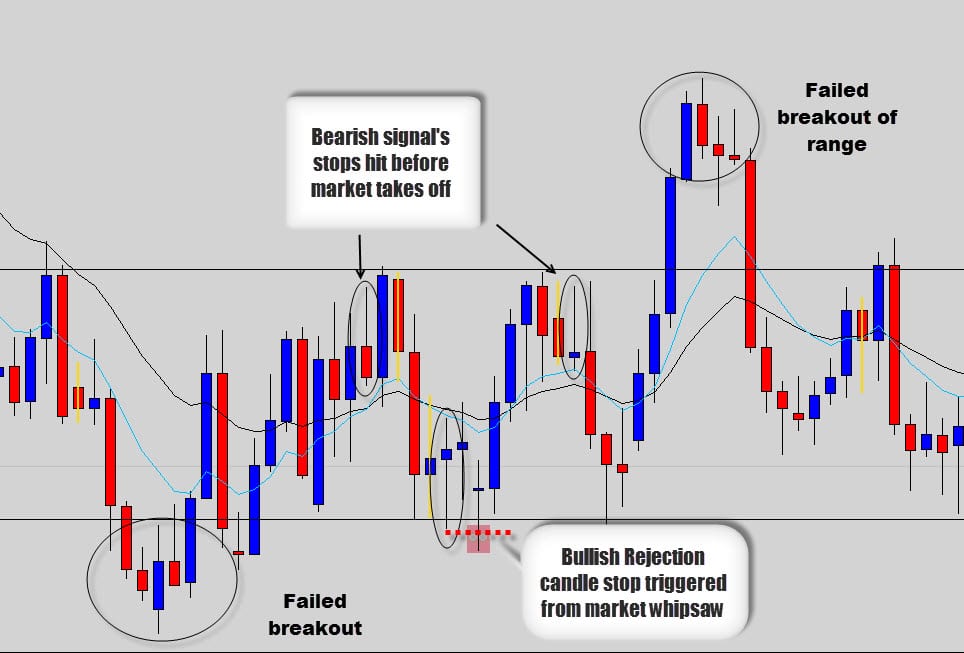
The above chart tells us a lot about the characteristics of ranging conditions. They are violent, produce unexpected large movements, whip up and down frequently, and produce random market spikes.
I hate ranging markets because they have no sense of direction and I find that to be dangerous, especially when I am into swing trading. With trending markets you know the odds are in your favor when trading with established momentum. Ranging markets don’t know where they want to go.
Forex historical data shows us ranging markets are a frenzy of competing market orders causing chaos on the charts. Sure, generally price bounces between two levels, but even then, the signals which form here aren’t too reliable.
In the example above, we’ve pointed out 3 signals that formed at the range boundaries. They were destroyed by the unstable whipsawing price action. During my earlier days when I used to trade in ranging conditions frequently, this used to sting me a lot. What I thought was a solid price action range signal ended up being a wipe-out. Or my stop was taken out first, and then the market turned around and continued in the original direction.
Go back through the Forex historical data and have a look at some of the previous ranging conditions. Focus on the price action behavior at the range boundaries and try to identify signals that appeared to be quality signals. Note how many are consumed by violent, unpredictable moves around the upper and lower turning points.
Sure, some range trades will work out of course. If you’re going to trade ranges, make sure the signals that are very dominant and paint a clear picture. Take a look at the example below from some Forex historical data…
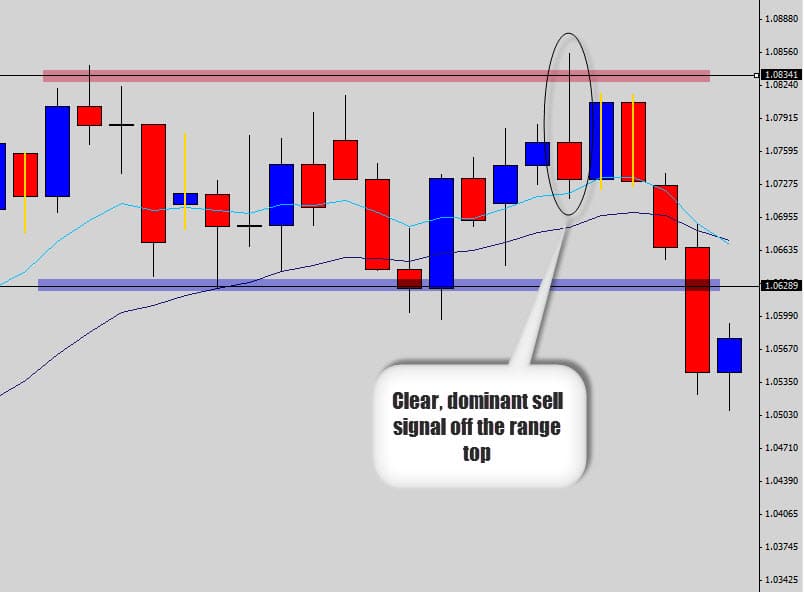
If you’re going to play in ranging markets then do yourself a favor and only stick to the signals that really scream out at you. Make sure the market communicates clearly price wants to move in a certain direction. Like in the chart above, there was a very powerful bearish rejection candle sell signal at this range top.
It’s very dominating on the charts and gets your attention swiftly. There was a lot of selling pressure here and a clear rejection of the range top. This is a price action setup we can start to build some value into and anticipate future market weakness.
The point is, ranging markets are tough to trade due to their unstable nature. If you’re going to take range trades make sure you’re very confident about the signal. Also, do your research, go back through the Forex historical data and study previous ranges to see for yourself how hard these beasts can be to tame at times.
Observe the Power of Weekly Levels From Forex historical data
How many times have you flicked over to the weekly chart and had a good look at the market from a longer point of view? If you haven’t, then you really should consider checking it out. Weekly levels play a big part in market reversals. Support and resistance levels visible from a weekly point of view contain a lot of weight, or ‘value’. The Forex historical data shows us these weekly turning points are where major price action events take place.
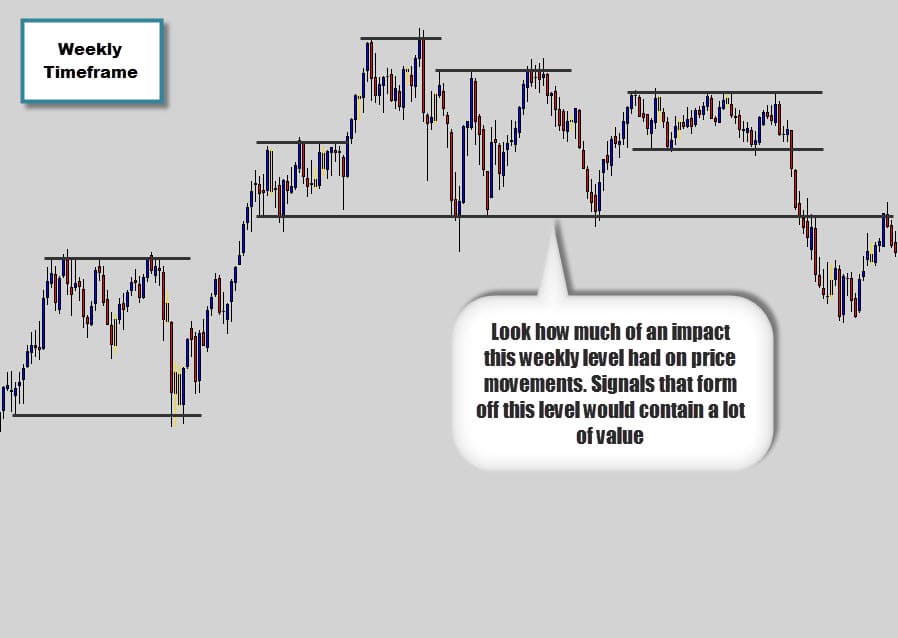
The Forex historical data above shows a ‘zoomed out’ weekly chart. From this perspective, we can quickly identify price levels that have been very significant turning points. When we use the weekly levels with our end of day trading strategies, you can start to collect the variables needed to identify potential market tops and bottoms.
When you look back through your Forex historical data, you will see how big of an impact weekly levels could have had on your trading. Ask yourself, how beneficial would taking notice of these weekly levels have been on your trading?
Putting it all together
The whole idea of going back through the Forex historical data is to really prepare you for the future. By learning these patterns now, you can start start to anticipate future market movements. The chart history will condition you to be less likely ‘spooked’ out of what you normally would consider an unexpected counter trend retracements.
For example, imagine you position yourself long into a bullish trend. You should be able to do a ‘rough forecast’ in your head approximately how you expect price to move.
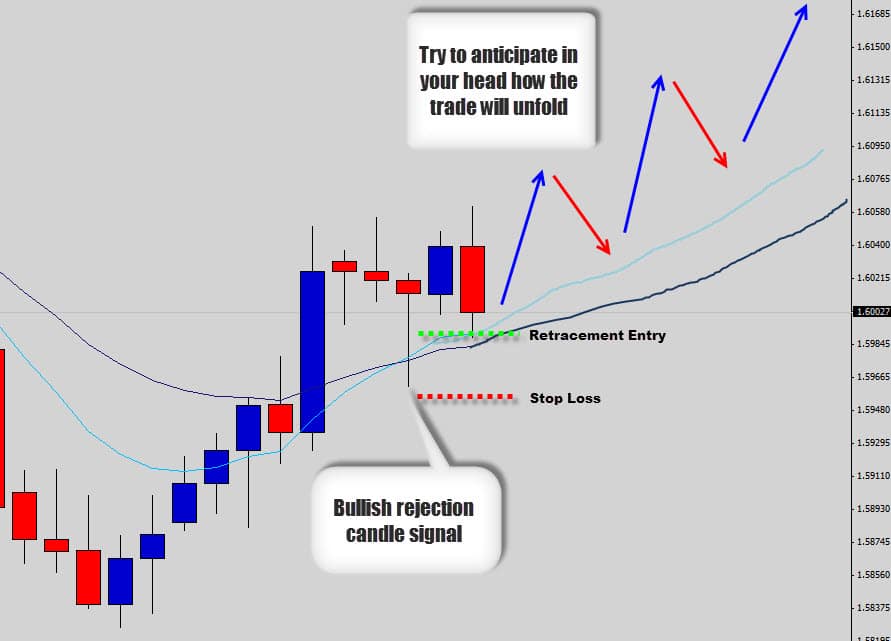
Note the example bullish trend trade setup above. Now by studying the Forex historical data and observing how trends have moved previously, you can start to map out in your head how your trade is most likely to develop. Hopefully, this way you’ll know what to expect during counter-trend retracements.
You’ll be less likely to panic once you’ve seen that it’s normal for your profits to dip down, even losing ground at times, before the trade eventually hits the target.
Understand that trades don’t hit 1:3 risk/reward target overnight. Your trade may need to be left to run for a generous amount of time if the markets are slow. Be ready for these kinds of conditions. The quicker you come to terms with it all, the less likely you are to emotionally interfere with your open trades.
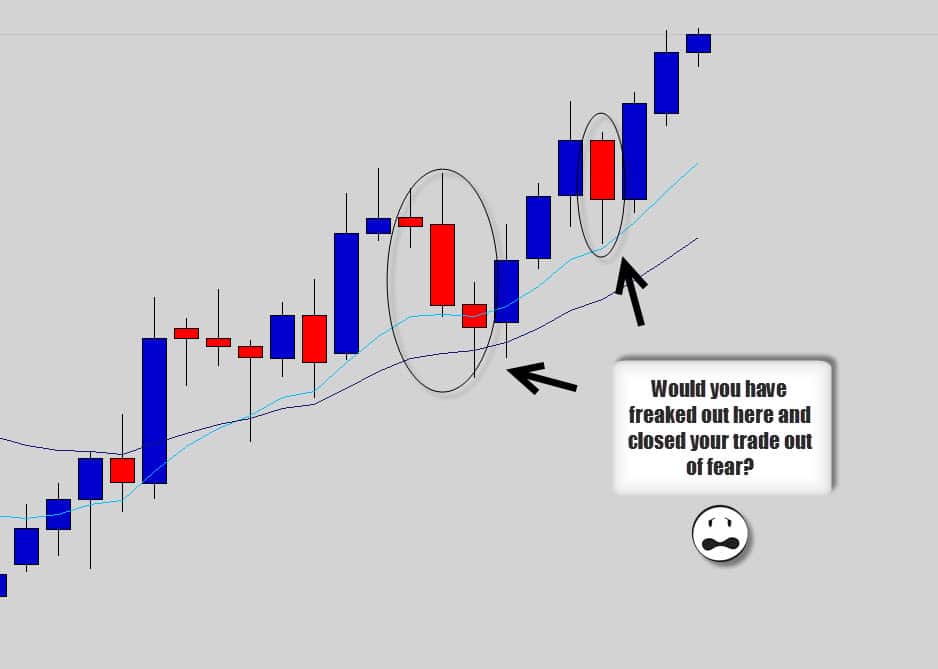
Above is the ‘after shot’ of the bullish trend trade we just looked at in the previous chart. We can see that the trade did mature into nice profit. As expected the market did retrace a couple of times. These retracements would have reduced the floating profit of the long position considerably at times. Traders who can’t stomach this, would have closed their positions out of fear. Something the Forex historical data could have demonstrated was unnecessary.
By using the Forex historical data, we can deduce that these counter trend movements are natural, and necessary. It’s actually abnormal for trades to just fire up and hit 1:3 risk reward without performing any market corrections.
Conditioning yourself to price movements via the Forex historical data will help you learn to deal with market movements that normally churn your stomach. The market is a representation of the overall human psychology, repeating itself over and over again. Use this repetition to your advantage – the clues are stored away in the Forex historical data, you just need to go look over them.
Trend trading with price action is something we are very passionate about here at The Forex Guy. We believe that trend trading should be straightforward, stress free and should not take up too much of our day-to-day lives. If you would like to learn more about the price action strategies we teach in our advanced price action trading course, then check out our war room membership.
All the best to your future trading success. Don’t forget to comment and share below.

Mutiu
Thank you Mr. Dale. Please when are you going to upload a new video because have really missed watching you on YouTube.
Thank you
Ssenkubuge Yusufsaid
You are such a wonderful person to let people all over the world share a meaningful information.
Who ever comes to see this, will definitely love forex trading and yet,many had lost hope.
Thanks a lot.
ghee
I want to thank you Dale for a very good clear explanation , purchasing your course is a must for a beginner even a pro …it’s totally add my confidence to take responsibility for my own trade not relying in any signal provider…for me commit learning (self-mastery)especially mental skills is the key to get along in trading…more power to you!
Olasunkanmi Abiodun
Dale woods, I don’t how to thank you for your efforts in making my trading life meaningful with your trading idea. Though, I am poor to join the war room today but even if it takes me years to gather the amount of $$$ to be one of your students in the class…..I must take it as my fate… May you live longer than expected to received me in the future. Thank you so very much.
Ben
Brilliant Statistician and Teacher due to explanations in a lay-man’s language. This serves as a powerful tool for understanding Forex Trade. It would probably rescue the 95% who usually fail to make it in Forex Trading.